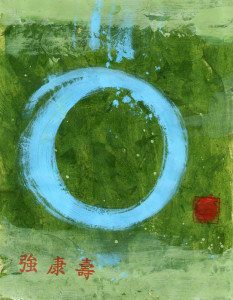
Have you ever watched with rapt attention a world-class ballet dancer in action? Or a champion figure skater? Or a first-rate martial artist? The physical and mental equilibrium displayed, the grace and fluidity of motion, create a poetry in space which gives us a true appreciation of the idea of balance. In the visual arts, we judge the beauty of a painting or sculpture by its balance, or the harmonious relationship of its parts. We make the same judgment when reading a poem or listening to a great work of music. And even in the field of law, justice is symbolized by a blindfolded woman holding a balanced scale in her hand, one in which both sides are of equal weight.
The idea of balance also teaches us much about health and disease. In common speech, when we are feeling out of sorts, we often say we are “out of balance.” A mentally ill person is considered “mentally imbalanced.” And in Western physiology, a healthy organism is one in “homeostasis,” a word derived from the Greek which means, essentially, a state of balance achieved between an organism and the environment.
In Oriental medicine, the concept of balance is fundamental to an understanding of health and disease. This is particularly the case with acupuncture, which concerns itself primarily with restoring or preserving health by correcting imbalances in the energy field of the body. In order to understand how this is done, we need to look at the body as the Chinese do. The ancient Chinese felt that everything in the universe was a form of energy, an idea that we find in modern physics. The Chinese word for this energy is chi (also spelled ‘qi‘). According to Chinese medical theory, the entire body is a manifestation of chi, and the major currents of chi flow in pathways called meridians. Along these meridians lie points where the chi can be easily influenced. If the chi is out of balance, disease will result. When the chi is in balance, the person will enjoy abundant health. The acupuncturist uses subtle diagnostic techniques to detect disturbances of the chi. Fine needles are then inserted at specific points on the body to re-establish the correct balance of energy. When this is done, the body is empowered to heal itself.
The idea of chi, or energy, is not peculiar to Chinese culture. The ancient Greeks called it pneuma, which has been translated as ‘breath of life’. The Sanskrit word is prana, the Tibetan lung. The African Bush people called it num. Different systems of medicine that concern themselves with energy have evolved through the ages, each with its own understanding of how physical and mental balance is to be restored. Among the more well-known modalities are Ayurveda (the Indian medical system), homeopathy, and chiropractic. In Chinese medicine, energy is understood in terms of yin and yang. Yin and yang are complementary opposites representing a dynamic balance of polar forces in nature. The ancient Chinese, who were astute observers of nature, noticed that natural processes were cyclical–summer changed into fall, which transformed into winter, which became spring, which became summer again. Day alternated with night, activity with repose. In other words, yin alternates with yang. The Chinese character for yang originally meant the sunny side of a mountain. Hence, yang was associated with heat, fire, expansion, energy, activity. The character for yin meant the shady side of a mountain, so yin was associated with rest, coldness, water, contraction, matter and inactivity. The interplay of yin and yang were also observed in the human body. For example, since yang is associated with fire and activity, a person with an excess of yang energy tends to generate a lot of heat and might show signs of mental and physical hyperactivity. A person with a deficiency of yang would be cold and might be mentally and physically sluggish. Yin is associated with water and inactivity, and a person with a yin excess might show evidence of an accumulation of bodily fluids, such as phlegm in the lungs, or edema. He or she might also tend to be sluggish. A person with a yin deficiency might have symptoms associated with dryness, such as dry skin and eyes.
Simply stated, acupuncture helps to promote or preserve health by restoring the balance of yin and yang in the mind and body through a manipulation of chi. A mental and physical equilibrium is then established which enhances a person’s sense of well-being, and helps to fight disease. The beauty of such a system of medicine lies in the fact that physical and mental imbalances can be detected and treated before they become clinically-observable diseases. In ancient China, acupuncture was used as a form of preventative medicine. In the Yellow Emperor’s Inner Classic, the oldest extant acupuncture text, we read that the physician was paid while his patient was healthy. When the patient became sick, the doctor lost his salary. Acupuncture also treats dis-ease once it has become manifest, and in fact, the World Health Organization lists over 40 types of disease acupuncture can help. But why wait till we are sick? It makes sense to create in ourselves a salutary balance, a mental and physical equilibrium that gives to our lives the grace and beauty of a work of art.